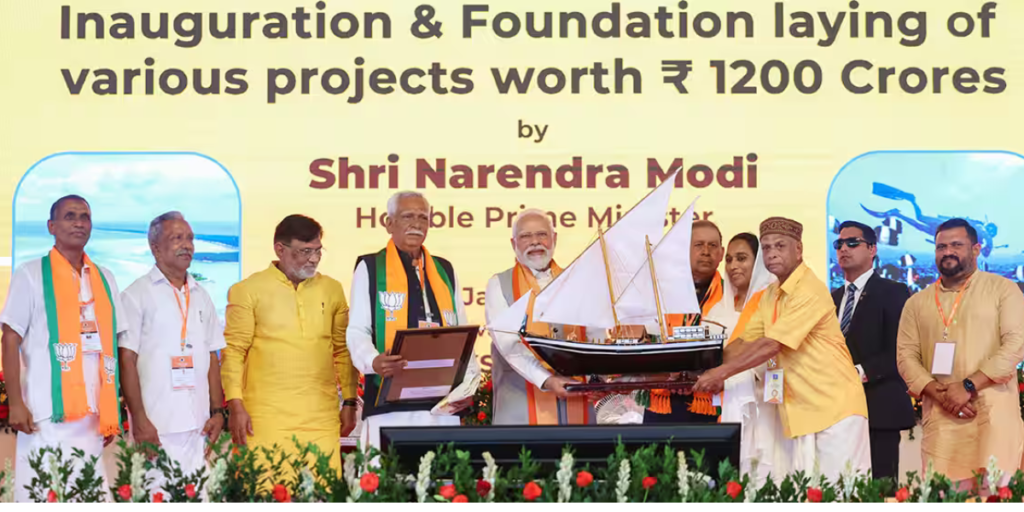Lakshadweep, a pristine Union Territory in India, recently hosted Prime Minister Narendra Modi, who not only inaugurated significant development projects but also immersed himself in the natural wonders of the islands. While PM Modi’s snorkeling adventure and morning walks along the pristine beaches captured the beauty of Lakshadweep, the development projects initiated during his visit hold promise for economic growth. However, these initiatives raise concerns about potential environmental impacts and the need for inclusive planning. This blog post explores the various dimensions of development in Lakshadweep, emphasizing the delicate balance between progress and preservation.
Table of Contents
Unveiling the Beauty of Lakshadweep

PM Modi’s visit showcased the breathtaking beauty of Lakshadweep, with the Prime Minister expressing awe at the stunning islands and the warm hospitality of the people. The shared pictures and experiences highlight the need to preserve the unique ecological and cultural aspects of this Union Territory.
Development Projects: A Catalyst for Change
The visit marked the inauguration and foundation laying of development projects worth 1156 crore rupees, focusing on crucial sectors like tourism, infrastructure, agriculture, education, and healthcare. These projects hold the potential to transform Lakshadweep’s economy and enhance the quality of life for its residents.
1. Tourism Boost
The projects aim to boost tourism, a key economic driver for Lakshadweep. Plans include the construction of eco-tourism beach villas in Minicoy and Suheli islands, with an estimated cost of Rs. 813 crore. This initiative could not only attract tourists but also generate revenue and employment opportunities for the local population.
2. Infrastructure Development
Investments in roads and transport infrastructure are expected to improve connectivity, making it easier for goods and people to move around the islands. Enhanced infrastructure could catalyze economic activities and contribute to overall development.
3. Agriculture and Allied Activities
Allocations in the Budget 2022-23 indicate a focus on agriculture and allied activities, with Rs. 19.41 crore earmarked. These projects aim to support local farmers and fishermen, boosting productivity and providing access to quality resources.
4. Education and Healthcare
The submarine Optical Fiber Cable (OFC) project, slated for completion by 2023-24, aims to enhance online education and e-medicine. This initiative could open up new opportunities in education, employment, and business for the islanders.
Concerns and Mitigation Strategies
Despite the potential benefits, there are concerns about the impact of development projects on the local environment and communities. Several measures are being taken to address these concerns and ensure sustainable development:
1. Financial Allocation
A significant portion of the budget has been allocated to agriculture, tourism, and overall development in Lakshadweep. Adequate funding is crucial for implementing projects responsibly and mitigating potential negative impacts.
2. Partnerships for Development
Partnerships with organizations like the National Co-operative Development Corporation (NCDC) aim to ensure all-round development for farmers and fishermen. Scaling up farming operations with better access to resources can contribute to the economic well-being of the local population.
3. Inclusive Consultation
Critics argue that the administration’s decision to invite global tenders for certain projects might marginalize local communities. Inclusive consultation with Panchayats, members of SPORTS, and the local population is essential to address their concerns and incorporate their perspectives into the planning process.
4. Environmental Safeguards
The delicate ecology of Lakshadweep requires urgent attention to prevent adverse environmental impacts. The government must devise strategies to safeguard the islands and implement projects that promote sustainable practices rather than hastening their decline.
Striking the Balance

As Lakshadweep stands at the crossroads of development, the challenge lies in striking a delicate balance between progress and preservation. Sustainable development necessitates careful planning, community involvement, and environmental consciousness. The government’s commitment to inclusive growth, financial allocations, and partnerships with relevant organizations are positive steps toward achieving this balance.
Conclusion
Lakshadweep’s enchanting beauty and the potential for economic growth through development projects present a unique opportunity for responsible and sustainable progress. By addressing concerns, involving local communities, and implementing stringent environmental safeguards, the government can ensure that Lakshadweep thrives economically without compromising its ecological and cultural integrity. The delicate dance between progress and preservation requires thoughtful strategies and a shared commitment to the well-being of the islands and their inhabitants.

